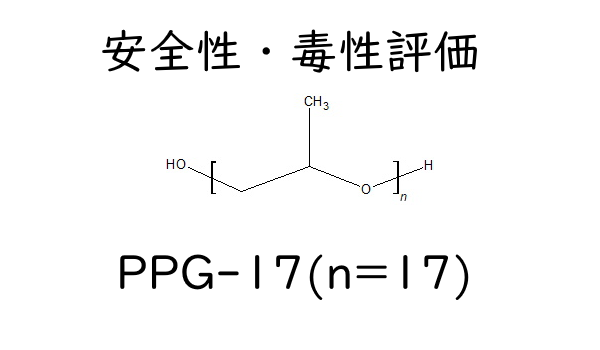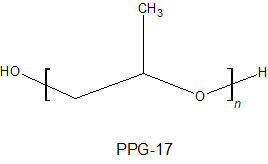PPG-17(PG)は安全な不活性保湿成分|日焼け止めの成分チェック

PPG-17(Polypropylene glycols)は、皮膚コンディショニング剤として、洗顔料、保湿剤、ボディソープ、シャンプーなどに利用される物質で、FDAにおいて皮膚に塗られる薬剤では98%、経口摂取される薬剤で92%もの高濃度での使用も許可されている危険性は低い物質です。基本的に不活性で、化粧品として使用される程度では反応が起こりにくいものです。
PPG-17の詳細・基本情報

構造的にOH基と水素が結合していて、H2O:水分をひきつける性質があります。日焼け止め、保湿液、化粧水としても利用されます。名称としてPPG(Polypropylene glycols)はポリプロピレングリコールのことで、PPG-17は上記構造のn=17の構造をしています。
According to the International Cosmetic Ingredient Dictionary and Handbook, international nomenclature cosmetic ingredient (INCI) names for the PPGs refer to the average “n” value corresponding to the propylene oxide chain length of the polymer; that is, PPG-3 would have an average chain length of 3.
プロピレングリコールという脂肪族アルコールが複数つながったものです。International Cosmetic Ingredient Dictionary and Handbookによると、PPGの国際命名化粧品成分名(INCI)は、ポリマーの酸化プロピレン鎖長に対応する平均「n」値を指します。つまり、PPG-3の平均チェーン長は3になるということです。
PPG-17の安全性・リスク
PPG-17の安全性やリスクに関しては、使用容量中50%までの濃度、それ以下の含有量であれば
- 無毒
- 発がん性なし
- 皮膚感作性なし
- 生殖毒性なし
とされています。市販品の多くは、PPG-17含有量が1%~2%になっているものがほとんどです。目に入れない、粘膜に使用しないなど化粧品として気をつけることは同じです。
1日の許容摂取量(非化粧品)
FAO / WHO合同専門家委員会(JECFA)によると、PPGのモノマー、PG(プロピレングリコール)の1日の許容摂取量ADIは「25mg/kg」で
25mg × 50 =1,250mg(1,25g)
です。厚生労働省の調査ではPG(プロピレングリコール)は人体に無害だと発表しています。
ただし、1日にプロピレングリコールを大量摂取した場合には消化吸収に問題があり、腹痛、下痢を引き起こす可能性が高いです。1日に10kgも20kgも摂取することはないと思いますが、これはプロピレングリコールというn=1の場合の話で、n=17のPPG-17になれば許容摂取量は大幅に減らさなければいけません。
PGの皮膚浸透はわずか
The dermal absorption of PG was determined in the outermost layers of skin using thermal emission decay–Fourier transform infrared (TED-FTIR) spectroscopy.24 Propylene glycol was applied to the fingertip of one human participant for 30 minutes using PG-soaked cotton wool. The site was wiped and allowed to dry for 1 minute. The thickness of the surface layer of stratum corneum probed was 0.71 µm. Measurements were performed every 25 minutes over a 3-hour period, with 1 measurement taking 15 minutes. The concentration of PG remaining at the surface of the stratum corneum decreased over time. At 12 and 32 minutes, the maximum concentration of PG was found at a depth of <1 µm, while at 107 and 157 minutes, the maximum concentration of PG was found at a depth of 3 to 4 µm. At a depth of 6 µm, the greatest concentration of PG, 0.2%, was seen at 32 minutes. The authors suggested that PG molecules diffuse into stratum corneum only to a depth of 6 to 7 µm, approximately. The researchers also suggested that PG molecules do not reach the dermis.
PGの皮膚吸収は、熱放射減衰-フーリエ変換赤外(TED-FTIR)分光法を使用して、皮膚の最外層で測定されました。プロピレングリコールは、PGに浸した脱脂綿を使用して人間1人の指先に30分間適用されました。部位を拭き取り、1分間乾燥させ、プローブした角質層の表層の厚さは0.71μmでした。測定は3時間にわたって25分ごとに実行され、1回の測定には15分かかりました。角質層の表面に残っているPGの濃度は時間とともに減少した。12分と32分では、PGの最大濃度は<1 µmの深さで見つかりましたが、107分と157分では、PGの最大濃度は3〜4 µmの深さで見つかりました。6 µmの深さでは、PGの最大濃度0.2%が32分で見られました。著者らは、PG分子が角質層に拡散するのは約6〜7 µmの深さであると示唆しています。
プロピレングリコールは指先に150分貼り付けておくと、角質層の3〜4µmの厚さまでは浸透していたとの報告です。これは同様に浸透していくとすると
24時間で28.8~38.4μm
まで浸透する可能性があるということですが、μm(マイクロメートル)は、10-6mという薄さで、1ミリメートルの1000分の1が1μmで、ほとんど浸透していないとも言えます。浸透したとしても無害です。
出典・参考
PPG-17|化粧品情報
https://cosmeticsinfo.org/ingredient/ppg-17
PPG-17|化粧品表示名称 成分詳細
https://www.cosmetic-info.jp/jcln/detail.php?id=2436
Safety Evaluation of Polyethylene Glycol (PEG) Compounds for Cosmetic Use
https://link.springer.com/article/10.5487/TR.2015.31.2.105
Safety Assessment of Propylene Glycol, Tripropylene Glycol, and PPGs as Used in Cosmetics
https://journals.sagepub.com/doi/full/10.1177/1091581812461381













